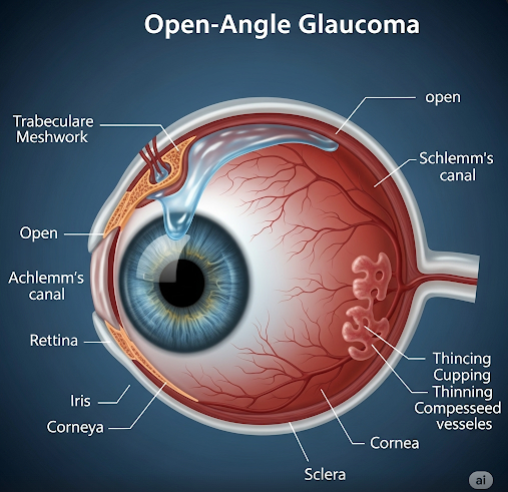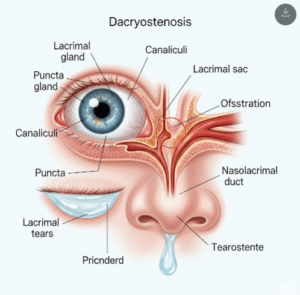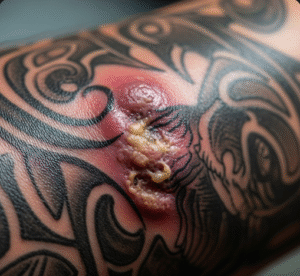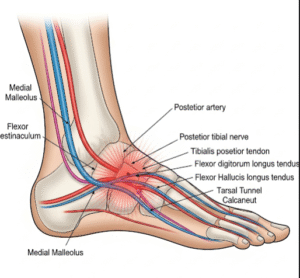Overview
Open-angle glaucoma is a chronic eye disease that causes progressive damage to the optic nerve, often associated with increased intraocular pressure (IOP). It is the most common form of glaucoma, accounting for over 90% of all cases. This condition typically develops slowly and painlessly, which means many people are unaware they have it until significant vision loss has occurred. If left untreated, open-angle glaucoma can lead to permanent blindness, but early detection and treatment can preserve vision.
What is Open-Angle Glaucoma?
Open-angle glaucoma occurs when the drainage angle formed by the cornea and iris remains open, but the trabecular meshwork (the eye’s drainage system) becomes partially blocked. This leads to a gradual buildup of intraocular pressure, which in turn damages the optic nerve — the structure responsible for transmitting visual information from the eye to the brain. Unlike angle-closure glaucoma, this form progresses slowly and without obvious symptoms in its early stages, earning it the nickname “the silent thief of sight.”
Symptoms
Open-angle glaucoma is often asymptomatic in the early stages. Symptoms typically appear after substantial damage to the optic nerve has occurred:
- Gradual loss of peripheral (side) vision
- Tunnel vision in advanced stages
- Difficulty seeing in low light
- Blurred vision (in later stages)
- No eye pain or redness in most cases
Because vision loss is irreversible, regular eye exams are essential for early detection.
Causes
Open-angle glaucoma results from a combination of genetic and environmental factors. The exact cause is not fully understood, but it is associated with:
- Inefficient drainage of aqueous humor through the trabecular meshwork
- Gradual increase in intraocular pressure
- Optic nerve susceptibility to pressure and reduced blood flow
While high IOP is a major risk factor, some individuals develop open-angle glaucoma with normal IOP, known as normal-tension glaucoma.
Risk Factors
Several factors increase the risk of developing open-angle glaucoma:
- Age over 40 (risk increases with age)
- Family history of glaucoma
- African, Hispanic, or Asian descent
- Diabetes and hypertension
- Thin corneas (low central corneal thickness)
- Prolonged use of corticosteroids
- Severe myopia (nearsightedness)
Complications
Without treatment, open-angle glaucoma can lead to:
- Permanent optic nerve damage
- Irreversible peripheral and central vision loss
- Blindness
- Psychological effects such as depression and anxiety due to vision impairment
Prevention
While glaucoma cannot be completely prevented, early detection is the best way to protect vision. Preventive strategies include:
- Regular comprehensive eye exams, especially after age 40
- Monitoring and controlling intraocular pressure
- Managing health conditions like diabetes or hypertension
- Avoiding prolonged use of corticosteroid medications unless supervised
- Educating at-risk individuals about the importance of routine screening
Treatment Options in Korea
South Korea is recognized for its advanced ophthalmologic care and state-of-the-art diagnostic tools for managing glaucoma. Treatment focuses on lowering intraocular pressure to slow or prevent further damage and may include:
- Eye drops: First-line treatment to reduce fluid production or improve drainage (e.g., prostaglandin analogs, beta-blockers, alpha agonists)
- Oral medications: For short-term pressure control when drops are insufficient
- Laser therapy:
- Selective laser trabeculoplasty (SLT) to improve fluid drainage
- Laser peripheral iridotomy in narrow-angle or combined cases
- Surgery:
- Trabeculectomy or tube shunt surgery in advanced or drug-resistant cases
- Minimally invasive glaucoma surgeries (MIGS) for moderate cases
Leading hospitals in Korea, such as Kim’s Eye Hospital, Seoul National University Hospital, and Samsung Medical Center, provide comprehensive glaucoma care, including early screening, customized treatment plans, and long-term monitoring with advanced imaging systems like OCT (optical coherence tomography) and visual field testing.













